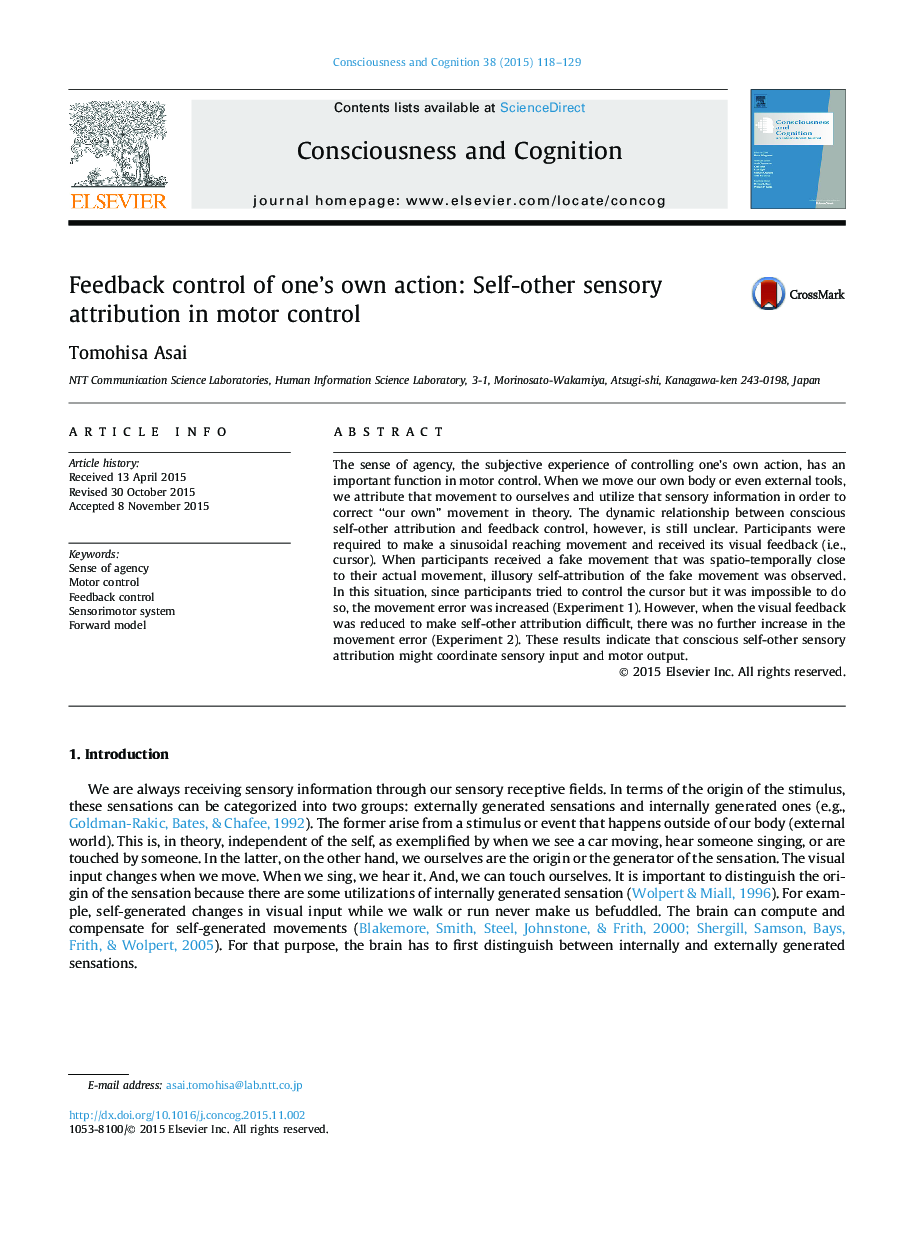| کد مقاله | کد نشریه | سال انتشار | مقاله انگلیسی | نسخه تمام متن |
|---|---|---|---|---|
| 7288814 | 1474173 | 2015 | 12 صفحه PDF | دانلود رایگان |
عنوان انگلیسی مقاله ISI
Feedback control of one's own action: Self-other sensory attribution in motor control
ترجمه فارسی عنوان
کنترل بازخورد از عمل خود فرد: خود ارضی دیگر در کنترل موتور
دانلود مقاله + سفارش ترجمه
دانلود مقاله ISI انگلیسی
رایگان برای ایرانیان
کلمات کلیدی
احساس آژانس، کنترل موتور، کنترل بازخورد، سیستم سنسور مدل پیش رو،
ترجمه چکیده
حس آژانس، تجربه ذهنی کنترل یک عمل شخصی، عملکرد مهمی در کنترل موتور دارد. وقتی بدن ما و یا حتی ابزار خارجی را حرکت می دهیم، ما این جنبش را به خودمان اختصاص می دهیم و از این اطلاعات حسی استفاده می کنیم تا ما را به درستی برساند؟ جنبش در نظریه با این حال، ارتباط پویا بین تخصیص هویت خودخواهی و کنترل بازخورد هنوز مشخص نیست. شرکت کنندگان بایستی یک حرکت سینوسی داشته باشند و بازخورد بصری (یعنی مکان نما) را دریافت کنند. هنگامی که شرکت کنندگان یک جنبش تقلبی دریافت کردند که به لحاظ فضایی و زمانی نزدیک به جنبش واقعی خود بودند، به خودی خودخواهی از جنبش جعلی مشاهده شد. در این وضعیت، از آنجا که شرکت کنندگان سعی کردند مکان نما را کنترل کنند اما این کار غیرممکن بود، خطای حرکت افزایش یافت (آزمایش 1). با این حال، زمانی که بازخورد بصری به سختی به خودی خود وابسته شد، افزایش بیشتر در خطای حرکت (آزمایش 2) وجود نداشت. این نتایج نشان می دهد که ارجاع هوشی خودسوزی دیگر ممکن است ورودی حسی و خروجی موتور را هماهنگ کند.
موضوعات مرتبط
علوم زیستی و بیوفناوری
علم عصب شناسی
علوم اعصاب شناختی
چکیده انگلیسی
The sense of agency, the subjective experience of controlling one's own action, has an important function in motor control. When we move our own body or even external tools, we attribute that movement to ourselves and utilize that sensory information in order to correct “our own” movement in theory. The dynamic relationship between conscious self-other attribution and feedback control, however, is still unclear. Participants were required to make a sinusoidal reaching movement and received its visual feedback (i.e., cursor). When participants received a fake movement that was spatio-temporally close to their actual movement, illusory self-attribution of the fake movement was observed. In this situation, since participants tried to control the cursor but it was impossible to do so, the movement error was increased (Experiment 1). However, when the visual feedback was reduced to make self-other attribution difficult, there was no further increase in the movement error (Experiment 2). These results indicate that conscious self-other sensory attribution might coordinate sensory input and motor output.
ناشر
Database: Elsevier - ScienceDirect (ساینس دایرکت)
Journal: Consciousness and Cognition - Volume 38, 15 December 2015, Pages 118-129
Journal: Consciousness and Cognition - Volume 38, 15 December 2015, Pages 118-129
نویسندگان
Tomohisa Asai,
